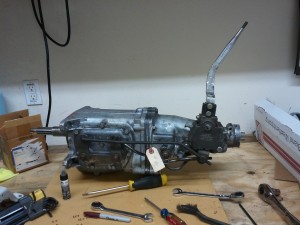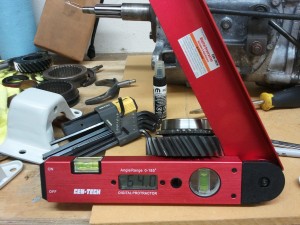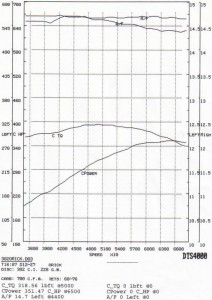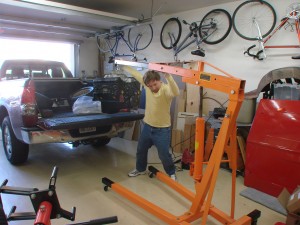Transmission rebuilt
Got the transmission back today from Harold’s Automotive in El Cajon. Like the rest of the car, it needed just about everything new – new second and third gears, new synchros, shift forks, and seals.
Made some marks at the input and output shafts to verify gear ratios-
As I suspected from the drive home (now over 1 year ago!) first gear is the tall 2.2, making this an M21 transmission, the standard unit in the ’67 Z28. Apparently the M20 wide-ratio was available as an option. Might seek one out if ProSolo launches with this tall first gear don’t work well.
The other thing it could be is the fabled “rock crusher” M22 Muncie. The M22 had a much shallower gear helix angle which made the gears stronger, but the transmission was very loud.
M20 and 21’s have an average helix angle of 35 degrees, M22’s have an average angle of 21 degrees. This one’s definitely an M21:
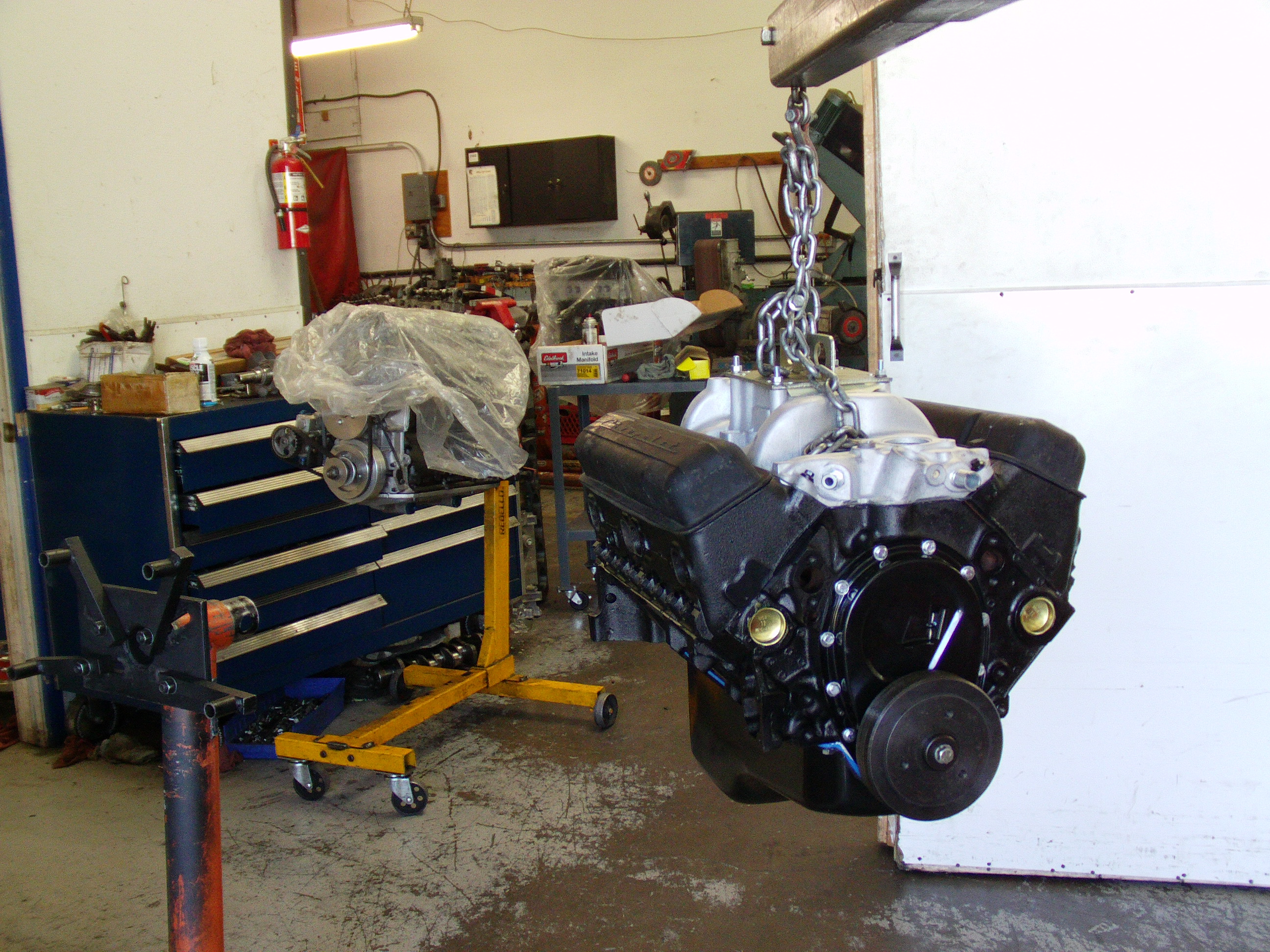
Ahh the 302
For us car people there’s a lot of different ways to find automotive pleasure. For some it’s all about the driving experience on a nice day. For serious competitors, it’s the thrill of a close and tight race. Plenty of folks enjoy “car porn”, a collection of shiny TIG-welded go-fast parts laid before a car like in a preview for the new “Fast and the Furious” movie, and the romance of bolting those parts on the car.
For me, a lot of the fun is the brainstorming and bench-racing that goes on around the question of “How would car X do in class Y?”. In this case, that question, is “How would a ’67 Z28 clone do in STX?”.
There’s a lot you can find out on the Internet, and with that information, you can start to form a halfway decent picture of how the car is going to perform. Here are some things you can find out pretty easily, to help in the evaluation process:
Dimensions – Length, width, wheelbase, height, ground clearance
Engine – Displacement, peak power, peak torque, redline
Gearing – 1st, 2nd, 3rd, final drive ratio(s) available
Wheel/tires – sizes, width, diameter
Weight – total and front/rear distribution
Suspension – type at front and rear, adjustability
These are the things usually comprising the “paper” looked at when people say “Car Z looks good on paper “. However, there’s a lot more to find out, and this information can take some digging to find:
Weight of the car in a trim like yours – both the total weight, and the contribution of your weight-reducing efforts to both front and rear axle weights. For Street Touring for instance, your front seats and mounts should weigh 25 pounds each – how much weight will be saved there? How much in headers, exhaust, lightweight battery? Are there any options you can remove? How low can the car be run on fuel? You have to look at published weights, or weights from people that have weighed their cars, then offset from those figures to account for the modifications you’d make.
How much wheel/tire can the car fit within your rules? How much of it can go inboard from stock?
Dyno pull of the engine with modifications made for your class. This may just be a cat-back exhaust, or that plus a CAI, headers, and a tune, or maybe even more extensive mods. You also have to take into account the different types of dyno (Mustang, Dynojet, Dynapack, direct engine dyno) and build in some correction factors amongst the dyno types and operators. Some massaging to do here, but a dyno is MUCH more valuable to evaluating autocross acceleration, than peak numbers.
In a future post I’ll maybe go into some detail into the thinking used to take all that information and try to apply it to autocross, to see what cars will be faster than others, where on course. But for now, that last bullet – engine dyno – is something I was missing somewhat in the pre-purchase planning stages of the build. I figured an 11:1 compression 5 litre V8 should be able to make more power than a 2.8 litre BMW or normally-aspirated RX8 rotary, but how much more, and where in the powerband? There’s all kinds of legend out there on the 302’s real power output, but not a lot of good hard data. You end up reading through a lot of threads like this:
http://www.camaros.net/forums/showthread.php?t=13864
And not really figuring much out. Like stock Z28 quarter mile times, you get numbers all over the place, but most are either wrong or completely unsubstantiated. I did find this dyno:
I happen to know the DTS4000 is an engine dyno, so this was done out of the car, likely without accessories and definitely without any drivetrain loss. That’s about 345hp – certainly more than the factory’s 290hp rating, substantiating many’s claims of the factory having underrated the engine. However we still don’t know the details of the build – whether the motor was fresh or high mileage, if it had headers or stock manifolds, whether it was tuned at all, etc. Assuming the reading is correct the air/fuel ratio seems on the lean side, over 14:1, not quite ideal for power.
So for me, the engine’s power was a really big question mark when it fired up for the first time this past Friday, 11/26.
J-Rho’s 302 is born, first startup
The smells coming off this thing were fantastic, it brought me back to the days as a young teen watching the cars go down the 1/4 mile at the now-defunct Carlsbad Raceway. I attribute the smell largely to the fuel used – we didn’t have any of the Sunoco GT100 fuel I plan to run on hand, so we made a mix of 91 octane pump gas and 110 octane leaded fuel. No fancy widgets here to foul up from the lead, just my brain to intoxicate with carcinogens, yummy! 🙂
There’s a lot of myth and legend about this motor out there, perhaps more than about any other small-block Chevy. The components used to make the engine changed from 1967 to ’68, and again in ’69. They made way more ’69 302’s than the other years, but in some ways, the ’67 engine is easier to reproduce. This is because there really isn’t anything special about the 302 motor in ’67, it was all parts-bin stuff – the same 4″ bore, small-journal block used by the 327 and 350; the forged crank from a 283; “fuelie” heads with 2.02/1.60 valves from the Corvette, along with its “30-30” cam. The carb is the same used on the SS396. There really wasn’t anything unique or special in the ’67 Z28 engine, which made piecing together a reproduction, possible. It took a few months, but my chosen engine builder (some may recognize the engine dyno room from these videos) has excellent connections in the vintage and A-Sedan racing circles, having built many smallblock Chevys under varying, but always strict, rulesets.
Here’s a video of a full pull, the only one where we went over 7 grand:
Those awful red boxes are covering the dyno operator’s readout showing instantaneous torque and horsepower figures, it also showed oil and water temps. Hopefully Randy Chase will forgive me, I can’t imagine he ever envisioned his Dashware software being used in this manner, especially in so crude a fashion.
In case you’re wondering, I won’t be publishing the numbers it made. They’ll go to the car’s next owner, whenever that is, but won’t otherwise be released until then. Same goes for some final details of the suspension (spring rates, alignment, shock settings) once I have it sorted. It’s not like I expect a dozen other Z28 clones to get built next week, where I’d be giving up some kind of competitive advantage. Perhaps to some extent, a goal in providing all the information in this blog isn’t to provide all the answers I find on a silver e-platter; rather, it is to help make some of my fellow racers more informed in the critical thinking of competition car building/tuning, and empower them to figure more things out on their own. Perhaps by doing so, some will be inspired to try new things or come up with some new ideas of their own, from which I can learn something in return. By making my competition better, it forces me to get better, which ups the overall ability levels of everyone involved. IMO there’s not enough innovation and outside-the-box thinking in autocross, which I hope to try to improve. And you don’t have to have an oddball car, or spend a ton of $ to innovate – I see innovations pretty much every year in the ST Civics, even though their rules have been essentially stagnant for over five years. It just takes effort.
So I don’t come across as a total tease, I will share this – I went in with a pretty well formed set of expectations of what the motor would do based on all the research I’d done. It didn’t quite meet my expectations at the top end – I’d read enough stories of people revving these motors to 7500rpm or higher, as delivered from the factory, to believe this sort of thing would be possible. After the dyno session, I plan to set the rev limiter at 7000rpm, well below the 7500+ I thought it would be good for. Anybody revving one of these things much past 7k rpm successfully, is either floating the valves something huge, or isn’t doing it with stock/ST-legal valvesprings.
At the same time, I was pleased by what it made in the midrange. We dyno’d with 1 5/8″ primary 4-1 headers, with a Y pipe into a single big 3.5″ muffler. I may retain a similar exhaust config on the car to reduce weight, or go with a dual 2.5″ exhaust. Bigger primaries or a larger OD header-back (note I didn’t say cat-back, ha!) might help top-end power, but the midrange does tend to be more important in autocross.
One advantage of a dual system, is it should be able to package more muffler longitudinally underneath the car. There’s also a 93db sound limitation at my local lot in San Diego, which I’d like to meet. Not sure yet if it’ll be possible to run the exhaust all the way out the rear of the car or not, with the rear suspension still being worked on.
So, it’s good to have the motor built, and home. It will be tuned again next year, after I have it in the car, with the air cleaner and header/exhaust system in place. There really isn’t much tuning to do anyway, just adjusting the distributor advance. Fortunately the air/fuel ratio was okay with the carb freshly rebuilt to stock specs- there’s definitely more power to be had with some tuning there, but I have no allowances to do so. Something I’ll have to keep working on with the rulesmakers – the fuel injected guys can adjust their ECUs to produce whatever sort of fueling they’d like, would be nice if the old-school carb’d cars were given the same freedom.
